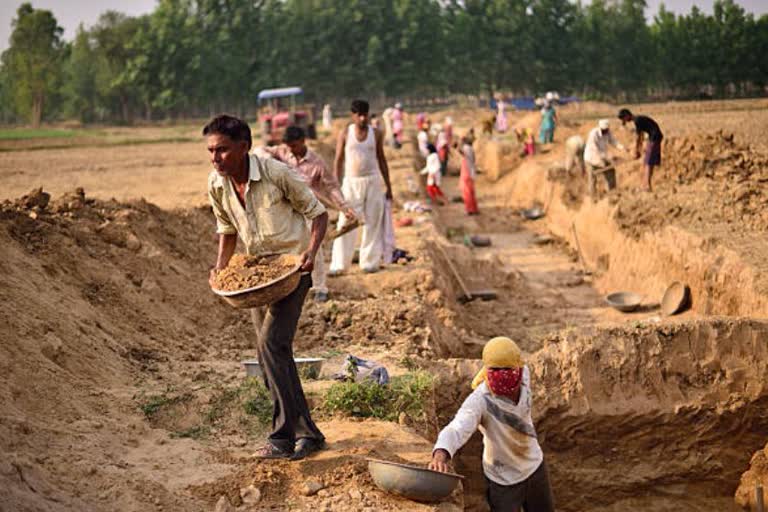Hyderabad: The unemployment rate fell to its pre-lockdown level of 8.5 per cent in the week ended June 21 as per the Centre for Monitoring Indian Economy (CMIE) report released on Tuesday.
The rate had spiked from 8.75 per cent in March to 23.5 per cent in April and May. It had peaked at 27.1 per cent in the week ended May 3. It began to fall thereafter - initially hesitatingly and then precipitously in June. The rate had fallen to 20 per cent in the last week of May that ended on the 31st, the report said.
In the first three weeks of June the unemployment rate dropped dramatically to first, 17.5 then 11.6 per cent and now 8.5 per cent.
The urban unemployment has fallen sharply but, it is still distinctly higher than the pre-lockdown levels. In the latest week ended June 21, the rate was down to 11.2 per cent. This is still over 200 basis points higher than the 9 per cent average in the period before the lockdown.
The 11.2 per cent unemployment rate in urban India in the week ended June 12 is much lower than the average of 25.83 per cent during the peak unemployment period of April and May or, even than the 23.18 per cent average for the entire 13-week lockdown period so far. But, it is still higher than the average unemployment rate of 9 per cent in the 13 weeks preceding the lockdown.
The big gain in employment is happening in rural India. And, it may see bigger gains in the months to come or at least sustain the current gains.
Source: Centre for Monitoring Indian Economy The unemployment rate dropped to 7.26 per cent in rural India in the week ended June 21. This is lower than it was in the pre-lockdown week ended March 22 when the rate was 8.3 per cent.
It is lower than the average unemployment rate in February and March 2020 which was 7.34 per cent and 8.4 per cent, respectively. It is much lower than the average 13-week lockdown period average of 20.3 per cent and, it is still a little higher than the 13-week average pre-lockdown rate of 6.8 per cent.
While relaxation of the lockdown has helped in alleviating the unemployment stress in general, rural India has apparently gained by the massive sudden increase in Mahatma Gandhi National Rural Employment Guarantee Scheme (MGNREGA) activities and also by a sharp increase in kharif sowing this year.
Read more:India retains its position as 3rd-largest economy on PPP basis for 2017
The person-days of jobs created in May 2020 shot up to 565 million. This is way higher than anytime in the recent past. It was for example, 53 per cent higher than the 370 million person-days of jobs created under the scheme in May 2019. It was 2.55 times the average monthly person-days of jobs created in 2019-20.
33 million households benefited from the scheme in May 2020. This again is 55 per cent higher than the number of households that benefited a year ago.
Surprisingly, in April when the unemployment problem was at its peak, MGNREGA was less active than warranted by the situation. The number of person-days in April 2020 was 141 million compared to 274 million in April 2019. Household beneficiaries were also much lower at 11 million compared to 17 million a year ago.
Partial data for June suggests that the scheme continues to power its employment relief measures aggressively. The number of person-days of jobs were 65 per cent of the year-ago numbers while the number of household beneficiaries were 95 per cent of the year-ago beneficiary households.
The southwest monsoon began on time and moved into central and western India ahead of schedule. Rainfall during the first fortnight was 32 per cent higher than the long-period average. Correspondingly, kharif sowing was 39.4 per cent higher than it was a year ago.
Aggressive use of the MGNREGA scheme by the government, timely rains and enhanced sowing activities seem to have helped engage rural India and bring the unemployment rate down.
As if on cue, the government is pushing for greater activism in rural India. The past week saw the Finance Minister announce and then the Prime Minister launch the Garib Kalyan Rojgar Yojana. This is to specifically alleviate the problem of migrant worker who have reached their villages.
Rs 500 billion have been announced for the scheme. This is not additional allocation but a repackaging of current schemes and front-loading of the expenses into a mission to be achieved in 125 days to create jobs in select 116 districts.
The overlap of Garib Kalyan Rojgar Yojana with MGNREGA is unclear. Nevertheless, rural unemployment can be expected to remain low till October 2020 at least. These efforts can also be expected to raise consumption demand from rural India.
